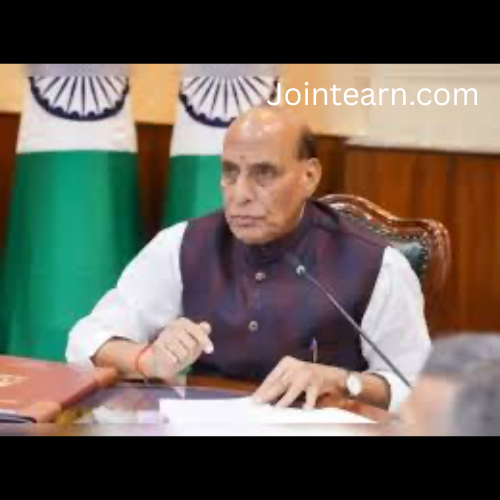
Defence Minister Rajnath Singh on Friday told the Indian Army’s top commanders that Operation Sindoor represented a new phase in India’s strategic and military thinking, demonstrating the nation’s readiness to respond to terrorism on its own terms with courage, precision, and restraint. Addressing the Army Commanders Conference held in Jaisalmer, Rajasthan, Singh said that Operation Sindoor marked the emergence of “New India’s Defence Doctrine,” which he described as one rooted in resolve, moral clarity, and strategic innovation.
The Army Commanders Conference, one of the most significant events in the Indian Army’s annual calendar, brought together the top leadership to discuss security challenges, review operational preparedness, and chart the course for modernisation and self-reliance in defence. Singh’s remarks came against the backdrop of heightened security concerns along the Line of Control (LoC) with Pakistan and the Line of Actual Control (LAC) with China, as well as ongoing regional and technological challenges that require constant adaptation by the armed forces.
During the conference, Singh and the senior Army leadership took stock of the overall security situation along both borders, focusing particularly on the Indian Army’s operational readiness to deal with any eventuality. He also visited the forward areas of Tanot and Laungewala in Rajasthan, near the Pakistan border—locations historically significant for their role in the 1971 India-Pakistan war.
Singh praised the Indian Army for its preparedness and professionalism, urging commanders to maintain vigilance, especially in the face of emerging forms of warfare such as cyber, electronic, and information-based conflicts. He underlined that modern defence is not just about military might but also about technological superiority and the ability to respond rapidly to evolving threats. “We must never underestimate our adversaries,” Singh said. “Our security challenges are diverse and complex. We must maintain readiness, modernise our capabilities, and focus on information warfare, defence diplomacy, and innovation.”
A major part of Singh’s address was devoted to Operation Sindoor, a military operation launched by India in May 2025 in retaliation for the Pahalgam terror attack. The attack, carried out by The Resistance Front—a proxy outfit of the Pakistan-based Lashkar-e-Taiba—had resulted in the deaths of 26 civilians. In response, the Indian Army conducted strikes against terrorist infrastructure across the border in Pakistan. The operation, which lasted four days, ended after both Indian and Pakistani military officials reached an understanding to cease hostilities on May 10.
Calling the operation a turning point, Singh said, “Operation Sindoor has given rise to a new strategic thinking that India responds to any terrorist activity on its own terms. This is New India’s Defence Doctrine, which embodies both resolve and courage.” He further added that Operation Sindoor would be remembered not just as a military campaign but as a symbol of India’s national strength, restraint, and respect for human dignity. “Our forces acted with policy precision and moral discipline. The operation isn’t over—our mission for peace will continue as long as even a single terrorist mindset remains alive,” he said.
The defence minister highlighted that Operation Sindoor demonstrated India’s military prowess and strategic clarity, showing that the strength of the armed forces lies not only in advanced weaponry but also in the discipline, ethics, and willpower of its soldiers. He emphasised that while modern warfare increasingly relies on technology, it is ultimately the human spirit that determines the outcome of battles. “Machines multiply strength, but the human spirit is what delivers victory,” he said.
In his address, Singh also praised the Indian Army’s critical role in maintaining peace and promoting development in Jammu and Kashmir since the abrogation of Article 370 in August 2019. “The abrogation of Article 370 was a historic decision. Today, the streets of Jammu and Kashmir are filled with hope, not unrest. People are confident about their future, and the Indian Army has played a vital role in creating this environment of peace and stability,” he said. Singh noted that governance in the region had become more responsive and locally driven, underscoring the importance of the military’s contribution to this transformation.
Referring to the situation on the border with China, Singh said that the ongoing talks and de-escalation measures along the LAC reflected India’s balanced yet firm foreign policy approach. “Our policy is clear—there will be dialogue, but our readiness on the border will remain intact,” he stated. Singh pointed out that India and China had reached an understanding in October 2024 to end the prolonged military standoff in the Ladakh sector, which began in April–May 2020 and had taken bilateral relations to their lowest point in six decades. Although both sides have agreed on de-escalation mechanisms, about 50,000 troops from each country remain deployed in the region.
The Army Commanders Conference was attended by Chief of Defence Staff General Anil Chauhan, Army Chief General Upendra Dwivedi, Defence Secretary Rajesh Kumar Singh, and Vice Chief of Army Staff Lieutenant General Pushpendra Singh, among others. The conference included detailed deliberations on “grey zone warfare,” an evolving concept referring to hybrid threats that fall below the threshold of conventional war but involve disinformation, cyberattacks, and covert operations. Discussions also covered the roadmap for achieving greater jointness among the armed forces, enhancing self-reliance through the “Atmanirbhar Bharat” initiative, and integrating innovation and indigenous technologies into the defence ecosystem.
Singh commended the Indian Army for its adaptability and resilience, calling it one of the most versatile forces in the world. “Whether operating in the freezing heights of Siachen, the scorching deserts of Rajasthan, or the dense forests of the Northeast, our soldiers continue to perform their duties with unmatched dedication,” he said. “Despite the challenging conditions, the Indian Army continues to evolve and strengthen national security.”
Emphasising the changing nature of warfare, Singh observed that contemporary conflicts are increasingly fought in “invisible domains” such as cyberspace, information networks, and outer space. He stressed that the Indian military must constantly upgrade its technological capabilities, enhance decision-making speed, and maintain the morale and willpower of its personnel. “In modern warfare, technology is a force multiplier, but courage and clarity of purpose remain irreplaceable,” he said.
As part of the conference proceedings, Singh virtually inaugurated a range of technological initiatives aimed at boosting the army’s efficiency and connectivity. These included the establishment of Edge Data Centres for the Konark and Fire & Fury Corps, which will provide advanced digital infrastructure for real-time operational support. Singh announced that by next year, all corps across the nation would be equipped with similar data centres. He also launched the “Sainik Yatri Mitra” app, designed to assist army personnel and their families during travel, and released the “Defence Millet Dishes Compendium,” compiled by the Army Service Corps Centre and College in Bengaluru to promote nutritional awareness.
In addition, Singh inaugurated several “Naman Centres” to support veterans and the families of fallen soldiers, reaffirming the government’s commitment to the welfare of the armed forces community. He paid homage to Indian Army troops by laying a wreath at the Laungewala Yudh Sthal and inaugurated the “Chandpuri Hall,” an audio-visual room dedicated to the memory of Major (later Brigadier) Kuldip Singh Chandpuri, who famously led the defence during the Battle of Laungewala in 1971. Singh also met and felicitated veterans who had participated in that historic battle, acknowledging their enduring contribution to national pride.
The defence minister also reviewed several infrastructure development projects at Laungewala, aimed at transforming the site into a national heritage and pride centre that showcases the Indian Army’s valour and resilience. He later attended a “capability demonstration exercise” that highlighted the army’s integration of new organisational structures, such as the Bhairav Battalion and Ashni Platoon, along with the latest technological innovations. The demonstration, combining legacy and modernity, symbolised the Indian Army’s ongoing efforts toward capability development and comprehensive force modernisation.
In his concluding remarks, Singh reiterated that India’s defence posture is one of strength, vigilance, and moral clarity. He stressed that while the nation seeks peace, it will not hesitate to act decisively against any threat to its sovereignty. “Our mission is peace, but it must be a peace built on strength, resolve, and the will to protect our people,” he said. The conference thus ended on a note of determination and confidence, underscoring the government’s vision for a technologically advanced, self-reliant, and ethically grounded Indian Army prepared for the challenges of the future.


Leave a Reply